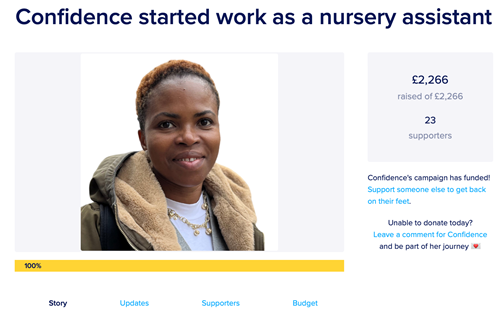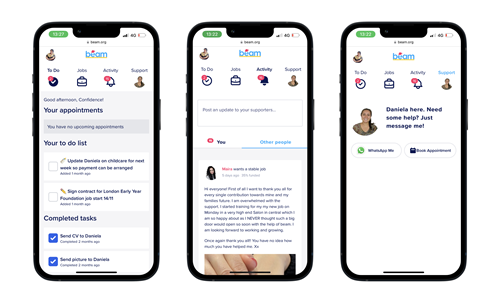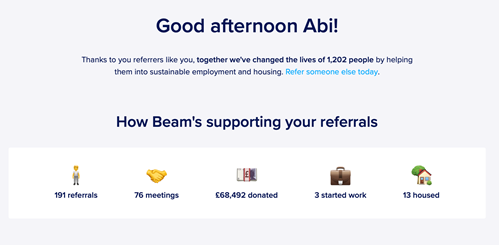05 Jan 2023
Innovating a way through the homeless crisis
2022 has been a difficult year for the homelessness sector. The number of people sleeping rough in London has gone up 24 per cent in a year. We’re also seeing a rise in the number of people being evicted from their homes, driven by rising rents and energy bills. In the North of England, this has led to a 50 per cent increase in homelessness applications.
As the cost of living crisis worsens, my fear is that homelessness will continue to worsen. This is backed up by a recent survey, where a third of Brits said they were worried about becoming homeless in 2023, while over half (56 per cent) of people believe that the cost of living crisis and recession will lead to more people becoming homeless.
Rising homelessness also means a new profile of people need to access homelessness support services. In Beam’s case, before the pandemic we were supporting people who had been homeless for an average of five and a half years. Now, we’re seeing a growing number of people accessing our service who have been homeless for under two years. In 2023, I suspect that number will be closer to 12 months.
As the diversity and profile of people experiencing homelessness evolves, it’s more critical than ever that we explore new routes to tackling this crisis.
One area that is often overlooked is how we can harness the power of technology to support those experiencing homelessness. For too long, homeless people have been locked out of the benefits that technology has brought to most of our lives. Just as the wealthiest people in society benefit from technology, whether that’s the latest smartphone or a Netflix subscription, homeless people should also reap the benefits.
At Beam, we’ve seen first-hand the positive role that technology can play in lifting someone out of homelessness - both in terms of personalising support around someone’s needs, connecting them with a supportive online community, and joining up support between different stakeholders.
Here are some of our approaches and learnings:
1. Personalising support
Homelessness is a complex issue that affects a diversity of people, meaning a one-size-fits-all model is unlikely to work. From my decade working in homelessness services, every person I’ve supported has faced multiple unique barriers, generally linked to a lack of skills, finances, confidence and support networks. Tackling all of these challenges together can be difficult.
One example of how we’ve tried to tackle this at Beam is through our online fundraising platform, which removes the specific barriers facing homeless people. Each person gets a fundraising page on our website, telling their story and itemising all financial barriers - for example, training, work tools, travel costs, smartphones, childcare and rental deposits. 90 per cent of donations are split equally, allowing everyone to reach their target within an average of 17 days. It’s a person-centric approach, designed around an individual’s unique goals and aspirations.

Confidence launched a crowdfunding campaign to remove her financial barriers
One person who has recently benefited from this approach is Confidence, a single mother of four living in temporary accommodation. Confidence became homeless after leaving an abusive relationship and was struggling to get by without a stable income. She dreamed of getting a job as a nursery assistant but needed support paying for childcare, a DBS check, travel costs and a laptop.
Within 13 days, Confidence reached her £2,266 fundraising target. A few weeks later, she started work at a nursery run by one of Beam’s employer partners, Leyf, and wrote this message: “Words failed me. I can’t believe it. Finally, I am back to work again.”
2. Building communities
After many years of personal difficulty, homeless people often lack the confidence and support needed to make a significant change to their lives. This got us thinking: what if we could use technology to build support networks around homeless people who are struggling with self-belief and isolation?
One way we address this at Beam is by connecting homeless people with an online community of 10,000 people who spur them on and become part of their new support network. This same technology allows homeless people to connect with their peers and read motivating stories of others in a similar position who have turned their lives around.

Beam’s app helps homeless people apply for jobs and connect with their peers
In the case of Confidence, she was supported by 23 kind people who sent her words of encouragement. People like David, who shared this message: “You're clearly resourceful and resilient, and your kids are lucky to have you as their mum. [I’m] very happy to help in bridging the financial gap to enable you to complete this positive move”.
And it’s clearly working. In a recent survey, 72 per cent of the people who use Beam said the social support they received from the crowd contributed to their success in starting a job or leaving homelessness - proving the important role that online networks can play in tackling homelessness.
3. Joining up stakeholders
Finally, digital platforms make it easier for different stakeholders - government, charities, employers, landlords and members of the public - to join-up support around people experiencing homelessness. They also enable service providers to be more transparent about the work they’re doing, which is crucial for measuring impact.
One example of how we’re doing this at Beam is through real-time reporting to all of our government customers. From a single page, they can see the number of residents that Beam’s supported into jobs and homes, how much money has been raised for their residents, and how much money we’re saving per person we support into work. In a similar way, members of the public also get their own personal impact page on Beam’s website similar to this one, showing all the people they’ve supported and where they’re at on their journey.

Referrers receive real-time updates on the people they’ve referred via a personalised dashboard
To find out more, go to beam.org
Seb is the co-founder and COO of Beam


